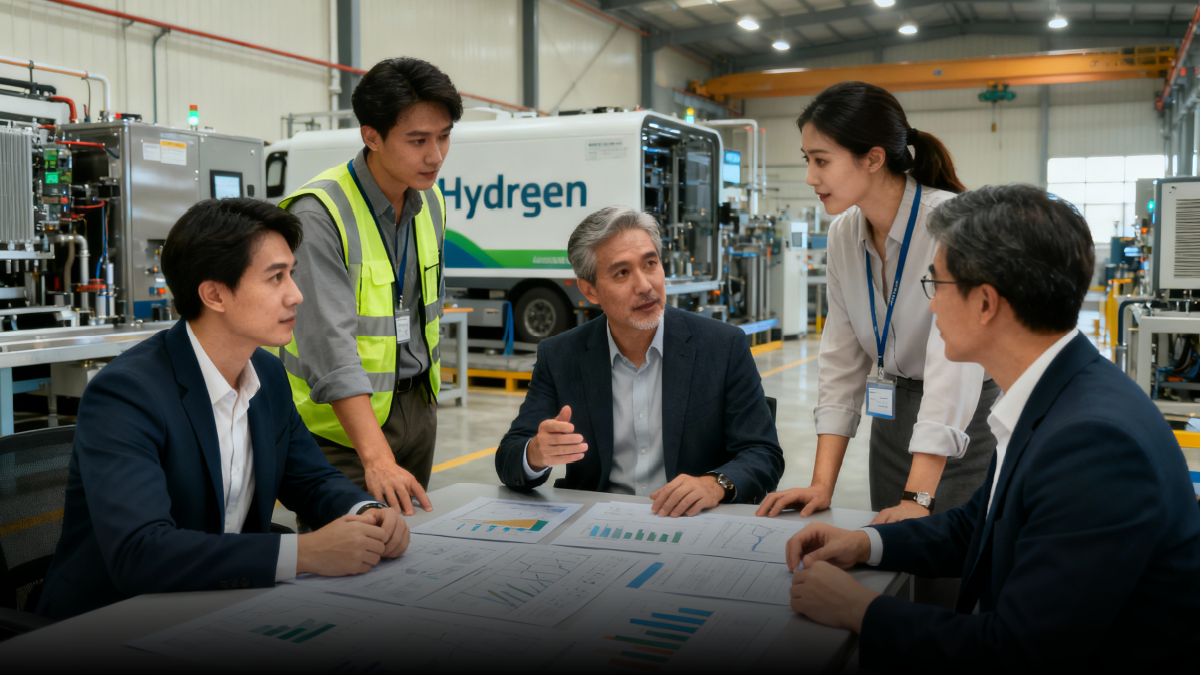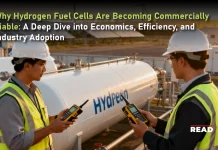The global energy transition looks easy only until you hit the sectors that don’t bend. Heavy duty transport, industrial heat, and long duration storage all sit in that stubborn zone where batteries stop being the hero everyone expects them to be. You can only add so much weight, wait so long to recharge, or redesign entire supply chains before the math breaks down. This is the reason why hydrogen continues to be one of the most talked-about topics. The IEA’s Global Hydrogen Review 2025 states that the global hydrogen demand already reached 100 million tonnes in 2024, which is an indication of the extent to which hydrogen is integrated into today’s industries even before the clean energy transition reaches its peak.
Now the shift is happening for real. Cost compression, smarter materials, and government backed investment are pushing hydrogen fuel cells out of the lab mindset and into commercial reality. What used to feel experimental is starting to look scalable. As these pieces line up, hydrogen fuel cells viability becomes less of a question and more of an outcome.
In the sections ahead, we’ll break this down through three pillars that actually matter for decision makers. First, the economics that are leveling the playing field. Second, the technology that’s unlocking better performance. Third, the industrial momentum that’s turning pilots into real markets.
The Economic Shift to Cost Parity for Hydrogen Fuel Cells

The funny thing about hydrogen is that its story was never about science. The science worked ages ago. The real fight was economics. And now that fight is bending in a new direction. Not perfectly. Not fast enough for the hype crowd. But definitely moving.
Let’s start with the factory floor because that’s where most of the cost pain began. Fuel cells used to be built like boutique furniture. Low volume. High complexity. Every component felt handcrafted. Naturally the price shot up and everyone questioned hydrogen fuel cells viability as if it was about chemistry instead of the bill of materials. Now the script is changing. Large scale manufacturing for fuel cell stacks and the entire Balance of Plant ecosystem is finally taking shape. When you shift from pilot lines to giga scale, automation stops being a nice to have and becomes the biggest cost killer. As factories mature, unit costs trend down the way solar did a decade ago. Not overnight but inevitably.
Then you have governments stepping in and acting like the shock absorbers for early market risk. The U.S. Infrastructure Act, the EU Hydrogen Strategy, and heavy Asian investment didn’t magically fix everything but they created a floor. Early developers suddenly had air bags. What truly unlocked momentum though is the rise of production tax credits. PTCs became the cheat code that made clean hydrogen pricing look competitive instead of aspirational. The industry basically got permission to sprint without breaking both legs.
Also Read: Smart Retail Technology: How AI and IoT Are Redefining the Future of In-Store Experiences in 2025
Of course fuel cell economics are tied to one thing above all else which is the price of clean hydrogen. You can optimize manufacturing all day but if the fuel is expensive the whole thing collapses. That is why everyone keeps pointing to the DOE Hydrogen Shot work from late 2024. Their pathway to one dollar per kilogram isn’t just a slogan. It lays out how electrolyzer technology can scale the same way lithium ion once did. If those cost curves land even halfway right fuel cells stop being a niche science project and start behaving like a real energy option.
So the shift is happening. Not with fireworks but with steady, structural moves that make the economics harder to argue with every single year.
Technological Breakthroughs Driving Efficiency and Durability

If the economics set the stage, the tech side is what actually keeps this whole hydrogen story from collapsing under its own weight. And let’s be honest, the early hardware had issues. Too much precious metal. Too low power density. Too fragile to survive real world abuse. Now the industry is quietly rewriting those flaws one by one.
Start with the cost monster everyone avoided saying out loud for years which is PGMs. Platinum group metals made fuel cells feel like you were building engines out of jewelry. That’s finally shifting because catalyst engineering has moved from basic chemistry to something closer to material artistry. With PGM alloys and clever nanostructures, labs started pushing the same output with a fraction of the metal. Suddenly the cost equation doesn’t look like a luxury hobby anymore. Even the HFTO Multi Year Program Plan backs this direction with targets like $2 per kilogram hydrogen production by 2026 and sharp cuts in system and storage costs. These targets aren’t motivational posters. They’re blueprints that labs and manufacturers are building around.
While that’s happening, power density is going through its own glow up. Earlier stacks were bulky and awkward which made every engineer working on trucks or ships roll their eyes. But membrane electrode assemblies have gotten smarter and stack layouts are being optimized instead of patched together. When you push more watts per liter or per kilogram you unlock real commercial flexibility. Trucks, maritime systems, and even tight urban applications stop feeling like a forced fit. Plus, IRENA’s electrolyzer cost work shows how efficiency improvements and scale up are trending in the right direction which feeds the whole ecosystem.
And then comes durability which was the deal breaker for fleets. If your stack starts degrading like old batteries after a few thousand hours you can forget heavy duty transport. So R&D teams went after lifetime the way battery engineers did ten years ago. The new target is north of twenty thousand hours and the focus is on stabilizing materials, reducing thermal stress, and blocking chemical breakdown. Hit that range and you suddenly have fuel cells that match the pace of commercial vehicle mileage instead of tapping out early.
Each of these breakthroughs doesn’t just improve specs. They chip away at the old doubts and make the technology feel like it’s finally stepping into adult mode instead of living in the prototype phase forever
Commercial Adoption and Infrastructure Momentum
The real acceleration in hydrogen fuel cells viability isn’t coming from lab breakthroughs alone. It’s coming from the places where companies actually have to put trucks on the road, ships in the water, and backup power in the ground without crossing their fingers. This is the zone where hydrogen finally stops behaving like a future concept and starts acting like a real commercial tool.
Heavy duty transportation is the clearest proof. Trucks, marine vessels, and rail systems run on brutal schedules where downtime feels like bleeding money. These sectors need long range, predictable performance, and refueling that doesn’t hijack operations. Batteries may shine for cars, but they struggle hard when weight climbs and distances stretch. Every extra kilowatt hour adds bulk, eats into payload, and forces longer charging windows. Hydrogen slips into that gap almost too cleanly. Fast refueling, long range, and the ability to stay light enough for commercial payloads make it the closest thing to a killer app. And once fleets start running numbers, they see the operational logic before they even get to the sustainability angle.
While transport grabs the spotlight, stationary and backup power is quietly becoming the second backbone of this shift. Data centers are the obvious testing ground because they absolutely cannot gamble on downtime. Diesel generators technically get the job done, but they pollute, they’re noisy, and they rely on fuel that spikes in price every few months. Fuel cells, by contrast, offer a stable zero emission power source that kicks in smoothly without the quirks of combustion. And when you stretch this out to grid stabilization, the case gets even stronger. Utilities everywhere are trying to solve long duration storage without building giant battery farms that degrade faster than planned. Hydrogen fuel cells slide into those mission critical roles with a level of reliability that feels built for the job.
All of this still needs an ecosystem, and that’s where infrastructure finally looks serious. The old model of scattered stations never had a chance because it solved nothing for scale. Now the world is moving toward Hydrogen Hubs where production, storage, pipelines, and demand sit inside one coordinated zone. When everything sits closer together, the economics stop breaking and distribution finally becomes repeatable. Governments see the potential too. According to the IEA’s 2025 review, public funding for low emissions hydrogen projects has reached 38 billion dollars, which sends a clear message that this isn’t another pilot phase. It’s the start of a build out.
Put it all together and you get a feedback loop. Transport fuels demand. Stationary power proves reliability. Infrastructure anchors the whole system. And at every step the numbers keep pushing hydrogen fuel cells viability from an idea to something commercial players can trust.
The Path to Mass Deployment
When you step back and look at the full picture, the story feels a lot more grounded than the hype cycles we’ve seen over the years. Hydrogen fuel cells viability isn’t riding on one lucky breakthrough. It’s the steady convergence of policy pressure pushing costs down, technology that’s finally behaving the way industries need it to, and real world deployments proving that hydrogen can carry its weight in tough commercial environments. That mix is what nudges hydrogen out of the research corner and into the mainstream energy conversation.
Still, getting to true mass adoption isn’t a straight road. The industry has to lock in consistent green hydrogen supply instead of relying on a mix that still leans on high emission production. Infrastructure also needs to stretch far beyond today’s concentrated hubs. You can feel the momentum, but the network needs time to catch up. Being upfront about these gaps actually strengthens the case because it shows the path is challenging but absolutely workable.
And that’s the real takeaway. Hydrogen has crossed the line from theory to practice. It’s no longer the energy source we keep promising for the distant future. It’s stepping into the market as a commercially competitive player with the potential to reshape transport, power, and heavy industry. The next few years won’t be about proving the chemistry. They’ll be about scaling the systems that finally make it run.




